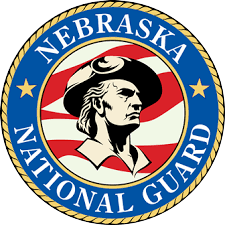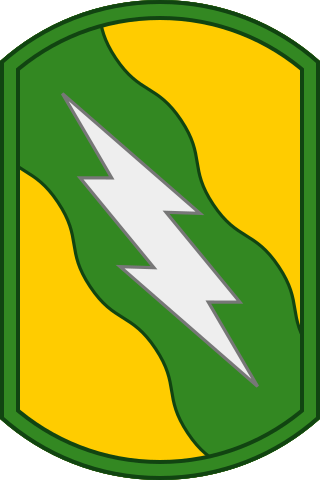
The 34th Infantry Division is an infantry division of the United States Army, part of the National Guard, that participated in World War I, World War II and multiple current conflicts. It was the first American division deployed to Europe in World War II, where it fought with great distinction in the Italian Campaign.

The 30th Infantry Division was a unit of the Army National Guard in World War I and World War II. It was nicknamed the "Old Hickory" division, in honor of President Andrew Jackson. The Germans nicknamed this division "Roosevelt's SS". The 30th Infantry Division was regarded by a team of historians led by S.L.A. Marshall as the number one American infantry division in the European Theater of Operations (ETO), involved in 282 days of intense combat over a period from June 1944 through April 1945. In the present day, the division's lineage continues as 30th Armored Brigade Combat Team, part of the North Carolina National Guard. The unit's most recent combat deployment was in 2019.

The United States 32nd Infantry Division was formed from Army National Guard units from Wisconsin and Michigan and fought primarily during World War I and World War II. With roots as the Iron Brigade in the American Civil War, the division's ancestral units came to be referred to as the Iron Jaw Division. During tough combat in France in World War I, it soon acquired from the French the nickname Les Terribles, referring to its fortitude in advancing over terrain others could not. It was the first allied division to pierce the German Hindenburg Line of defense, and the 32nd then adopted its shoulder patch; a line shot through with a red arrow, to signify its tenacity in piercing the enemy line. It then became known as the Red Arrow Division.

The Wisconsin Army National Guard ("Guard") has dual state and federal roles, and is jointly funded and maintained by both governments. Its federal mission is to provide trained units to the United States Army in time of war or national emergency. Its state mission is to help civil authorities protect life and property and preserve peace, order, and public safety in times of natural or human-caused emergencies. The governor, who is the commander in chief of the Guard when it is not activated for federal service, appoints the adjutant general who directs the Wisconsin Department of Military Affairs, of which the Guard is a part. Members of the National Guard are typically part-time soldiers who attend unit drills one weekend per month and serve a two-week annual tour of active duty. All officers and enlisted personnel must meet the same physical, education, and other eligibility requirements as members of the active-duty services.

Below is an estimated list of the major units deployed within the Multi-National Force – Iraq and other United States military units that were operating in Iraq under the U.S. Central Command (USCENTCOM) in 2009, during the Iraq War.

The 157th Maneuver Enhancement Brigade, also known as the Iron Brigade, is based out of Milwaukee, Wisconsin. It was formerly known as the 57th Field Artillery Brigade, at which time its subordinate organizations included the 1st Battalion, 126th Field Artillery Regiment and the 1st Battalion, 121st Field Artillery Regiment from the Wisconsin Army National Guard, plus the 1st Battalion, 182nd Field Artillery Regiment of the Michigan Army National Guard. Not to be confused with the famous "Iron Brigade" of the Civil War, its nickname was traditionally given to crack artillery units in the Civil War. It was during World War I that the 57th Field Artillery Brigade earned its nickname as it spent many hours at the front and fired more artillery rounds than any brigade in the American Army.

The Georgia Army National Guard is the Army National Guard component of the Georgia National Guard, administratively part of the Georgia Department of Defense. It consists of more than 11,100 citizen-soldiers training in more than 79 hometown armories and regional facilities across the state. Georgia’s Army Guard is the sixth largest in the nation and includes combat, combat support and combat service support units.

The North Carolina Army National Guard (NCARNG) is North Carolina's principal military force. The force is equipped by the federal government and jointly maintained subject to the call of either. The professional head of the North Carolina Army National Guard is the Adjutant General.

The South Carolina Army National Guard is a component of the United States Army and the United States National Guard. Nationwide, the Army National Guard comprises approximately one half of the U.S. Army's available combat forces and approximately one third of its support organization. National coordination of various state National Guard units is maintained through the National Guard Bureau.

The Nebraska Army National Guard is a group of Army National Guard units in the U.S. state of Nebraska. The Adjutant General for these units is Major General Daryl L. Bohac, who was announced as the new Deputy Director of the Army National Guard in May, 2013, and assumed his new duties later in 2013.
FOB Grizzly was a U.S. Army Forward Operating Base located within Camp Ashraf, Diyala province, Iraq. It was located near Al Khalis, approximately 20 kilometers west of the Iranian border and 60 km (37 mi) north of Baghdad.

The 81st Stryker Brigade Combat Team is a modular mechanized infantry brigade of the United States Army National Guard based in Washington, Oregon and California. On 9 July 2015 it was announced that the 81st Brigade would convert from being an Armored BCT to a Stryker BCT.

The 2nd Battalion, 127th Infantry Regiment traces its origins to the 4th Infantry Battalion, Wisconsin National Guard.

The 128th Infantry Regiment is a United States military unit of the Wisconsin National Guard, currently represented by the 1st Battalion, 128th Infantry Regiment. The 128th has served as part of the American Civil War, Spanish–American War, Mexican Civil War, World War I, World War II, Iraq War and the Afghanistan War.

The 155th Armored Brigade Combat Team is a brigade combat team of the Mississippi Army National Guard.
The 105th Cavalry Regiment is a regiment in the United States Army National Guard.

The 632nd Armor was an armored regiment of the Wisconsin Army National Guard from 1963 until 2001. A parent regiment under the Combat Arms Regimental System and U.S. Army Regimental System, the 632nd Armor was represented in the Wisconsin Army National Guard by the 1st and 2nd Battalions between 1963 and 1967. The 2nd Battalion was eliminated in a 1967 reorganization, while the 1st Battalion continued in existence until 2001.

The 205th Engineer Battalion is an engineer battalion of the Louisiana Army National Guard. It is part of one of the 225th Engineer Brigade, one of largest engineer brigades in the United States Army National Guard. The 205th Engineer Battalion is headquartered in Bogalusa, LA in Washington Parish with the remaining companies and detachments located in St. Tammany, Tangipahoa, Ascension, and Jefferson parishes. The battalion provides command and control to plan integrate, and direct execution of three to five assigned engineer companies and one Forward Support Company (FSC) to provide mobility in support application or focused logistics.
The 120th Field Artillery Regiment is a field artillery regiment of the Wisconsin Army National Guard.


















